| |
Is
our solar system typical of other solar systems? Well, unfortunately
we do not really know because by virtue of the fact astronomers
are observing very distant objects, it is much easier to detect
the telltale signs of more "extreme" systems. The
animations below show how the parent star is influenced by its
orbiting planets. Smaller, more distant planets (like earth)
exert less influence than closer, more massive planets - Think
Jupiter, but only a quarter of the distance out.
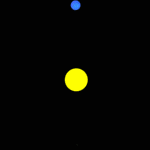 |
Left
shows an Earth-like planet exerting some gravitational tug
on the parent star. Right shows a larger planet in a closer
orbit which is able to create a greater wobble on its parent
star. The kind of disturbance on the right is more easily
detected because it is more severe but it means many Earth-like
planets remain invisible to atronomers. |
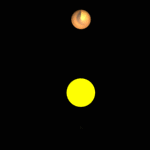 |
So,
instead of looking at the known types of extra-solar planets
systems which have been detected around other stars, this page
examines how a more typical system might form. Planet-forming
is not an exact science, so random chance always plays a part
leading to curiosities which have a strange history.
When planets form close to stars there is a
greater abundance of heavy elements. This leads to planets with
substantial rocky cores. However, if a large planet forms at
a significant distance from the star a heavy atmosphere is able
to survive. Hence it is possible to have a hybrid of Venus and
Jupiter. The most important question is: What planets carry
water? The creation of planets in the "Goldilocks Belt"
(where its not too hot or too cold) is very important. It likely
that one or two bodies will occupy this space.

| The
closest world to the star, which we shall call "Alpha",
is a giant by Earth's standards. However, unlike the giants
of our system it is rock not gas, and the intense heat long
ago destroyed the atmosphere leaving only its rocky surface.
Being
so close to the star, "Alpha" is at the mercy
of incredibly powerful gravitational forces which superheat
the core and generate fantastic levels of tectonic activity.
As a result the planet is covered with volcanoes which
constantly stream fresh lava over the surface.
|
 |
Surface
temperatures are so high that some metals are vaporised which
gives the planet a transient atmosphere of nickel and iron.
The Extra-Solar planet of Mu Arae d is likely to be a
real example of this kind of world. Click
here for more information.
 |
The
second world, "Beta", is of a similar composition
to "Alpha", however it is twice the distance from
the star which means that the heavy atmosphere has survived.
The solar winds are gradually eroding "Beta" but
much slower than "Alpha" creating a tail of streaming
gas. |
Beneath
the dense yellow clouds, huge numbers of volcanoes jet out sulphur
dioxide contributing to the already severe greenhouse effect.
Sulphuric acid rains into seas of molten rock while gigantic bolts
of lightning sear down.
The
two large moons of this world are also volcanic nightmares tortured
by the gravity of their parent planet and the nearby star.
| Further
out we finally find a world which we could almost call
home. "Gamma" is a rocky world about twice the
size of Earth. It has a molten core and quite a thick
mantle but its density is a little low and consequently
has a thin atmosphere.
Unlike
Earth, it has no individual tectonic plates which means
that there are no volcanoes.
|
|
Water
is in abundance across the planet although the mean surface temperature
is a little too hot to be comfortable to humans.
The
high temperature also means more water vapour in the atmosphere
and therefore quite a lot of cloud cover. It
has two small moons only a few hundred kilometres across.
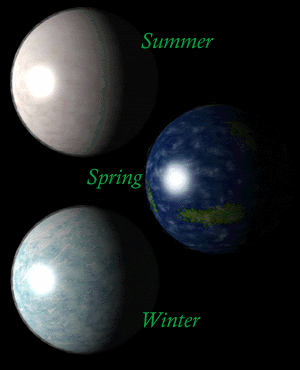 |
"Delta"
is the oddball of the star-system. Its basic composition
is the same as "Gamma", however its orbit is
massively perturbed.
Vast
water oceans exist on the surface, but the ellipse of
the planet's orbit takes it to massive seasonal extremes.
At one point the planet passes close enough to the star
for its oceans to boil off into the atmosphere, totally
clouding it over, however, in the winter season temperatures
drop so low that the entire world glaciates. Only during
a short time in the year does the temperature balance
and the planet appear Earth-like.
|
Very
faint rings around this planet are the remnants of whatever
other planet collided with "Delta" and caused it to
be knocked off its orbit.
At
its perihelion "Delta" passes inside the orbit of
"Gamma" and at its aphelion it moves out beyond the
fifth planet, "Epsilon".
| Just
outside the coldest fringe of the "Goldilocks Belt"
we have "Epsilon", an enormous gas giant greater
in diameter than Jupiter but very similar in composition.
The
heat in and around "Epsilon" creates a turbulent
atmosphere churning with huge storms.
Its
system of moons is diverse. The closest moon is tugged
by "Epsilon's" gravity, heating the interior
and causing extensive volcanic activity. |
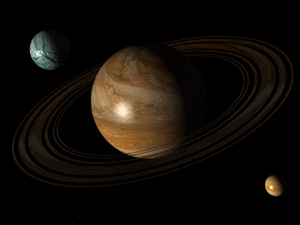 |
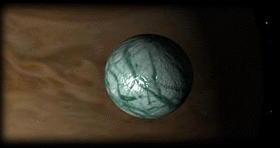 A
little further away the second moon is an unremarkable ball
of rock, but the third moon is covered with ice. Although the
star is not close enough to melt it, the effect of "Epsilon's"
gravity is. The strong tidal effects cause geothermal activity
which create hot underwater channels and the vast ocean beneath
a surface of ice. Lines run across the moon's surface where
the hot channels have reached the surface and freeze. A
little further away the second moon is an unremarkable ball
of rock, but the third moon is covered with ice. Although the
star is not close enough to melt it, the effect of "Epsilon's"
gravity is. The strong tidal effects cause geothermal activity
which create hot underwater channels and the vast ocean beneath
a surface of ice. Lines run across the moon's surface where
the hot channels have reached the surface and freeze.
"Epsilon's"
ring system is formed from ancient collisions between the planet's
moons.
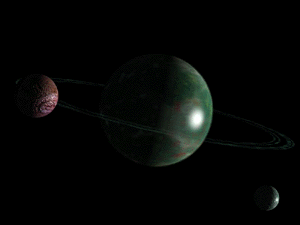 |
As
the heating effect of the star grows weaker the further
out we go, the final significant planet in our system is
"Omega". It is a giant, around the size of Saturn,
but it is not a true gas planet, it is an ice giant.
Its
methane atmosphere lacks the energy of the inner giants
and the planet's edge hazes our into space. High clouds
in the atmosphere are the only surface features.
|
The
six large moons are all cold and icy, but the one closest to "Omega"
is effected by the gravity of the planet enough to cause significant
geological activity. But on this frozen moon it is not lava but
ice which is ejected.
| Out
beyond the last main planet there are three or more co-orbitals.
Small, rocky bodies which are made up of the dregs of
the proto-planetary disc. These objects, barely large
enough to constitute planets orbit the star at the very
fringes if its influence. These are merely the tip of
the massive Kuiper belt of objects which extends out millions
of miles.
Beyond
them, the interstellar void.
Click here to read
about real solar systems other than ours. |
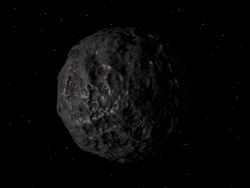 |
Gavin
Rymill 1999
|
|